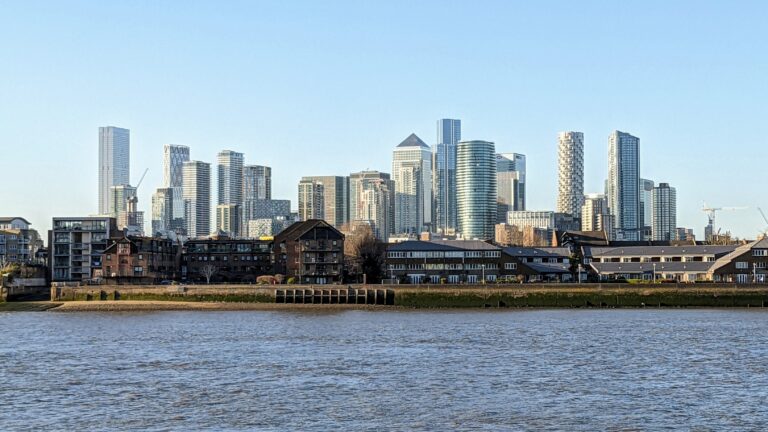Before Canary Wharf was redeveloped, before the bright lights, skyscrapers and expensive real estate, it was one of the busiest piers in the world. The Canary Wharf site was owned by the West India Dock Company during its Victorian and Edwardian heyday. The Port of London was established as an authority in 1909, taking over control of the Thames Peninsula in the East End, the gateway to the Isle of Dogs, from the West India Wharf Company, primarily to receive fruit from the Mediterranean and the Canary Islands. This trade led to one prominent wharf and adjacent warehouses being named Canary Wharf.
The port industry declined when freight transport became containerized in the 1960s, and the wharf closed in 1980 when the British government proposed redeveloping the area. This led to the establishment of the London Docklands Development Corporation in 1981 and the granting of 'Urban Enterprise Zone' status to the Isle of Dogs in 1982.
Today, Canary Wharf has been transformed into a skyscraper district, with many of the City of London's banks and financial institutions spilling east into the borough of Tower Hamlets. With its own unmanned urban railway, the Docklands Light Railway, and regional airport (City of London) opening in 1987, just as the stock market was booming, access to the area quickly became much easier. It has become. But by the time the pier finally opened for business in 1991, the commercial market had collapsed and Olympia and York Canary Wharf Ltd. filed for bankruptcy.
Bankers, concerned that Canary Wharf would eventually create direct competition with the Square Mile, pushed for changes to the City of London's urban planning plan to expand the supply of new office space in the City of London itself. Got it. This led to the collapse and failure of the Canary Wharf project conceived during the Thatcher era.
In 1999, Canary Wharf Group, an international consortium of companies, acquired ownership of the land for US$1.2 billion and appointed Paul Reichmann as chairman. The group is taken over in 2004 by Glick Family Investments, Concerns is affiliated with Morgan Stanley backed the acquisition with the help of its descriptively named Songbird Estates PLC.
The site currently includes approximately 16 million square feet of office and retail space, nearly half of which is owned by Canary Wharf Group. Many major banks, media outlets, agencies, and global and European headquarters are located here. The European Medicines Agency used to be located here. However, after the UK left the EU, it moved to Amsterdam and was replaced by the UK's own Medicines and Healthcare Products Regulatory Authority, the MHRA.
Residents confess that Canary Wharf doesn't have a very social atmosphere. There's a shopping mall and a few cinemas, surrounded by lush trees, but access to central London has been made easier by many recent bolt-ons to the London Underground network, including the Jubilee Underground, but there's no community spirit. Very little in that respect. Docklands Light Railway and the brand new Elizabeth Line. There are currently 2,300 apartments on site, with another 2,300 currently under construction. There is property to suit every income level, and the promise is that researchers and scientists will be able to live nearby. Canary Wharf is today described as a city within a city.
Today we can see the evolution of a new community in Canary Wharf. It's the largest community. wet lab European (laboratory certified for hazardous substances). Canary Wharf Group and Kadans Science Partners have announced a joint venture to develop a 750,000 sq ft hub focused on life sciences, a beloved industry of the UK government.
At this time, this business has no monetary value. However, the amount is thought to be around £500m. The new building will house ground-breaking state-of-the-art laboratories and innovation spaces for the life sciences sector. It will be 22 storeys high and will be based at North Quay, conveniently adjacent to Canary Wharf station on the Elizabeth line. It will be designed by New York firm KPF and is expected to be completed in 2026.
flower bedBusiness partners and sponsors AXA IM Orts: A company headquartered in the Netherlands, an investment manager with a background in French insurance companies and a European leader in the development and management of life science buildings and “ecosystems”.
The global life sciences industry is growing by the day, and it appears that the UK is the designated vehicle to grow into a global life sciences superpower, which is the UK government's stated goal. In essence, our lives become their science, and the British people become a valuable scientific commodity.
But at what cost and on what basis? Apparently the government has sold us to the world as lab rats for the rest of the planet. It is certainly a highly valuable commodity and one would argue that its safety is overseen by the MHRA. The MHRA is the same agency whose Yellow Card Alert System failed to alert millions of citizens. danger Regarding the damage caused by the new coronavirus vaccination.


